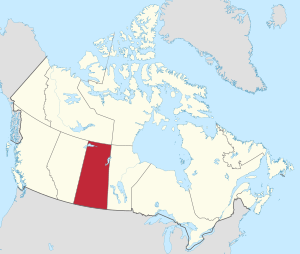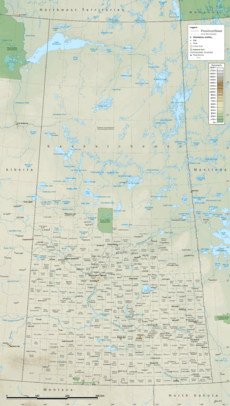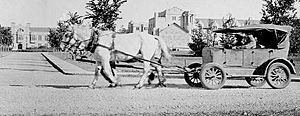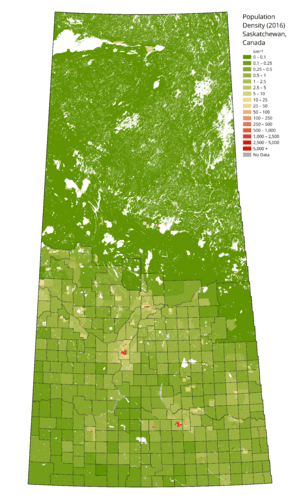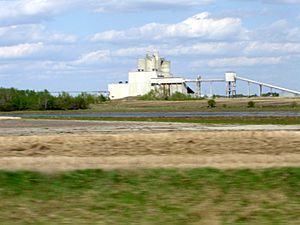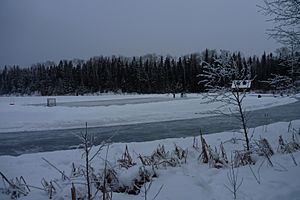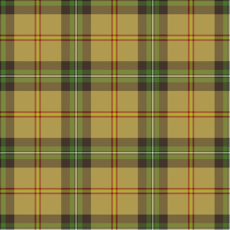Saskatchewan facts for kids
Quick facts for kids
Saskatchewan
|
|||
|---|---|---|---|
|
|||
| Motto(s): | |||
| Country | Canada | ||
| Confederation | September 1, 1905 (split from NWT) (10th, with Alberta) | ||
| Capital | Regina | ||
| Largest city | Saskatoon | ||
| Largest metro | Greater Saskatoon | ||
| Government | |||
| • Type | Parliamentary constitutional monarchy | ||
| Area | |||
| • Total | 651,900 km2 (251,700 sq mi) | ||
| • Land | 591,670 km2 (228,450 sq mi) | ||
| • Water | 59,366 km2 (22,921 sq mi) 9.1% | ||
| Area rank | Ranked 7th | ||
| 6.5% of Canada | |||
| Population
(2021)
|
|||
| • Total | 1,132,505 | ||
| • Estimate
(Q2 2024)
|
1,231,043 | ||
| • Rank | Ranked 6th | ||
| • Density | 1.91/km2 (4.9/sq mi) | ||
| Demonym(s) | Saskatchewanian (official) | ||
| Official languages | English | ||
| GDP | |||
| • Rank | 5th | ||
| • Total (2015) | CA$79.415 billion | ||
| • Per capita | CA$70,138 (4th) | ||
| HDI | |||
| • HDI (2019) | 0.921 — Very high (8th) | ||
| Time zones | |||
| year-round in most areas | UTC−06:00 (Central) | ||
| Lloydminster and nearby areas | UTC−07:00 (Mountain) | ||
| • Summer (DST) | UTC−06:00 (Mountain DST) | ||
| Postal abbr. |
SK
|
||
| Postal code prefix |
S
|
||
| ISO 3166 code | CA-SK | ||
| Flower | Western red lily | ||
| Tree | Paper birch | ||
| Bird | Sharp-tailed grouse | ||
| Rankings include all provinces and territories | |||
Saskatchewan (![]() i/səˈskætʃ(ə)wən/ SƏ-skatch-(Ə-)wən, Canadian French: [saskatʃəˈwan]) is a province in Western Canada, bordered on the west by Alberta, on the north by the Northwest Territories, on the east by Manitoba, to the northeast by Nunavut, and to the south by the United States (Montana and North Dakota). Saskatchewan and Alberta are the only landlocked provinces of Canada. In 2024, Saskatchewan's population was estimated at 1,231,043. Nearly 10% of Saskatchewan's total area of 651,900 km2 (251,700 sq mi) is fresh water, mostly rivers, reservoirs, and lakes.
i/səˈskætʃ(ə)wən/ SƏ-skatch-(Ə-)wən, Canadian French: [saskatʃəˈwan]) is a province in Western Canada, bordered on the west by Alberta, on the north by the Northwest Territories, on the east by Manitoba, to the northeast by Nunavut, and to the south by the United States (Montana and North Dakota). Saskatchewan and Alberta are the only landlocked provinces of Canada. In 2024, Saskatchewan's population was estimated at 1,231,043. Nearly 10% of Saskatchewan's total area of 651,900 km2 (251,700 sq mi) is fresh water, mostly rivers, reservoirs, and lakes.
Residents live primarily in the southern prairie half of the province, while the northern half is mostly forested and sparsely populated. Roughly half live in the province's largest city, Saskatoon, or the provincial capital, Regina. Other notable cities include Prince Albert, Moose Jaw, Yorkton, Swift Current, North Battleford, Estevan, Weyburn, Melfort, and the border city of Lloydminster. English is the primary language of the province, with 82.4% of Saskatchewanians speaking English as their first language.
Saskatchewan has been inhabited for thousands of years by indigenous peoples. Europeans first explored the area in 1690 and first settled in the area in 1774. It became a province in 1905, carved out from the vast North-West Territories, which had until then included most of the Canadian Prairies. In the early 20th century, the province became known as a stronghold for Canadian social democracy; North America's first social-democratic government was elected in 1944. The province's economy is based on agriculture, mining, and energy.
Saskatchewan is presently governed by Premier Scott Moe, a member of the Saskatchewan Party, which has been in power since 2007.
In 1992, the federal and provincial governments signed a historic land claim agreement with First Nations in Saskatchewan. The First Nations received compensation which they could use to buy land on the open market for the bands. They have acquired about 3,079 km2 (761,000 acres; 1,189 sq mi), new reserve lands under this process. Some First Nations have used their settlement to invest in urban areas, including Regina and Saskatoon.
Contents
Etymology
Its name derived from the Saskatchewan River. The river was known as kisiskāciwani-sīpiy ("swift flowing river") in the Cree language.
Geography
As Saskatchewan's borders largely follow the geographic coordinates of longitude and latitude, the province is roughly a quadrilateral, or a shape with four sides. However the 49th parallel boundary and the 60th northern border appear curved on globes and many maps. Additionally, the eastern boundary of the province is partially crooked rather than following a line of longitude, as correction lines were devised by surveyors prior to the homestead program (1880–1928).
Saskatchewan is part of the Western Provinces and is bounded on the west by Alberta, on the north by the Northwest Territories, on the north-east by Nunavut, on the east by Manitoba, and on the south by the U.S. states of Montana and North Dakota. Saskatchewan has the distinction of being the only Canadian province for which no borders correspond to physical geographic features (i.e. they are all parallels and meridians). Along with Alberta, Saskatchewan is one of only two land-locked provinces.
The overwhelming majority of Saskatchewan's population is located in the southern third of the province, south of the 53rd parallel.
Saskatchewan contains two major natural regions: the Canadian Shield in the north and the Interior Plains in the south. Northern Saskatchewan is mostly covered by boreal forest except for the Lake Athabasca Sand Dunes, the largest active sand dunes in the world north of 58°, and adjacent to the southern shore of Lake Athabasca. Southern Saskatchewan contains another area with sand dunes known as the "Great Sand Hills" covering over 300 square kilometres (120 sq mi). The Cypress Hills, located in the southwestern corner of Saskatchewan and Killdeer Badlands (Grasslands National Park), are areas of the province that were unglaciated during the last glaciation period, the Wisconsin glaciation.
The province's highest point, at 1,392 metres (4,567 ft), is located in the Cypress Hills less than 2 km from the provincial boundary with Alberta. The lowest point is the shore of Lake Athabasca, at 213 metres (699 ft). The province has 14 major drainage basins made up of various rivers and watersheds draining into the Arctic Ocean, Hudson Bay and the Gulf of Mexico.
Climate
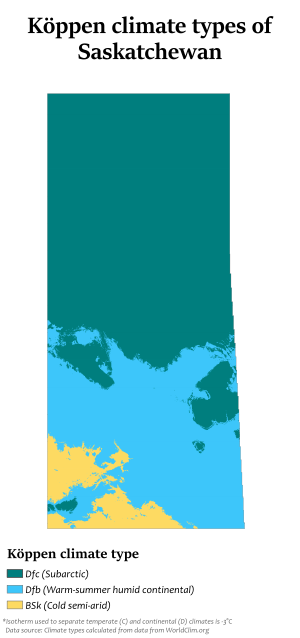
Saskatchewan receives more hours of sunshine than any other Canadian province. The province lies far from any significant body of water. This fact, combined with its northerly latitude, gives it a warm summer, corresponding to its humid continental climate (Köppen type Dfb) in the central and most of the eastern parts of the province, as well as the Cypress Hills; drying off to a semi-arid steppe climate (Köppen type BSk) in the southwestern part of the province. Drought can affect agricultural areas during long periods with little or no precipitation at all. The northern parts of Saskatchewan – from about La Ronge northward – have a subarctic climate (Köppen Dfc) with a shorter summer season. Summers can get very hot, sometimes above 38 °C (100 °F) during the day, and with humidity decreasing from northeast to southwest. Warm southern winds blow from the plains and intermontane regions of the Western United States during much of July and August, very cool or hot but changeable air masses often occur during spring and in September. Winters are usually bitterly cold, with frequent Arctic air descending from the north. with high temperatures not breaking −17 °C (1 °F) for weeks at a time. Warm chinook winds often blow from the west, bringing periods of mild weather. Annual precipitation averages 30 to 45 centimetres (12 to 18 inches) across the province, with the bulk of rain falling in June, July, and August.
Saskatchewan is one of the most tornado-active parts in Canada, averaging roughly 12 to 18 tornadoes per year, some violent. In 2012, 33 tornadoes were reported in the province. The Regina Cyclone took place in June 1912 when 28 people died in an F4 Fujita scale tornado. Severe and non-severe thunderstorm events occur in Saskatchewan, usually from early spring to late summer. Hail, strong winds and isolated tornadoes are a common occurrence.
The hottest temperature ever recorded anywhere in Canada happened in Saskatchewan. The temperature rose to 45 °C (113 °F) in Midale and Yellow Grass. The coldest ever recorded in the province was −56.7 °C (−70.1 °F) in Prince Albert, which is north of Saskatoon.
| City | July (°C) | July (°F) | January (°C) | January (°F) |
|---|---|---|---|---|
| Maple Creek | 27/11 | 81/52 | -5/-16 | 23/4 |
| Estevan | 27/13 | 81/55 | -9/-20 | 16/-4 |
| Weyburn | 26/12 | 79/54 | -10/-21 | 14/-6 |
| Moose Jaw | 26/12 | 79/54 | -8/-19 | 18/-2 |
| Regina | 26/11 | 79/52 | -10/-22 | 14/-8 |
| Saskatoon | 25/11 | 77/52 | -12/-22 | 10/-8 |
| Melville | 25/11 | 77/52 | -12/-23 | 10/-9 |
| Swift Current | 25/11 | 77/52 | -7/-17 | 19/1 |
| Humboldt | 24/11 | 75/52 | -12/-23 | 10/-9 |
| Melfort | 24/11 | 75/52 | -14/-23 | 7/-9 |
| North Battleford | 24/11 | 75/52 | -12/-22 | 10/-8 |
| Yorkton | 24/11 | 75/52 | -13/-23 | 9/-9 |
| Lloydminster | 23/11 | 73/52 | -10/-19 | 14/-2 |
| Prince Albert | 23.9/11.1 | 75/52 | -13/-25.2 | 9/-13 |
History

Saskatchewan has been populated by various indigenous peoples of North America, including members of the Sarcee, Niitsitapi, Atsina, Cree, Saulteaux, Assiniboine (Nakoda), Lakota and Sioux. The first known European to enter Saskatchewan was Henry Kelsey in 1690, who travelled up the Saskatchewan River in hopes of trading fur with the province's indigenous peoples. The first permanent European settlement was a Hudson's Bay Company post at Cumberland House, founded in 1774 by Samuel Hearne. In 1762 the south of the province was part of the Spanish Louisiana until 1802.
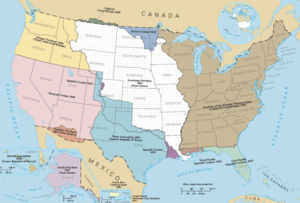
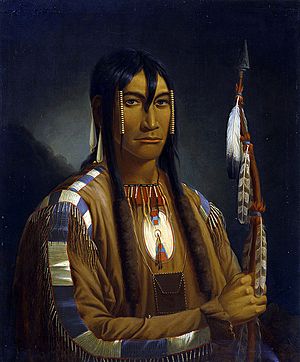
In 1803 the Louisiana Purchase transferred from France to the United States part of what is now Alberta and Saskatchewan. In 1818 it was ceded to the United Kingdom. Most of what is now Saskatchewan, though, was part of Rupert's Land and controlled by the Hudson's Bay Company, which claimed rights to all watersheds flowing into Hudson Bay, including the Saskatchewan River, Churchill, Assiniboine, Souris, and Qu'Appelle River systems.
In the late 1850s and early 1860s, scientific expeditions led by John Palliser and Henry Youle Hind explored the prairie region of the province.
In 1870, Canada acquired the Hudson's Bay Company's territories and formed the North-West Territories to administer the vast territory between British Columbia and Manitoba. The Crown also entered into a series of numbered treaties with the indigenous peoples of the area, which serve as the basis of the relationship between First Nations, as they are called today, and the Crown. Since the late twentieth century, land losses and inequities as a result of those treaties have been subject to negotiation for settlement between the First Nations in Saskatchewan and the federal government, in collaboration with provincial governments.
In 1885, post-Confederation Canada's first "naval battle" was fought in Saskatchewan, when a steamship engaged the Métis at Batoche in the North-West Rebellion.
A seminal event in the history of what was to become Western Canada was the 1874 "March West" of the federal government's new North-West Mounted Police. Despite poor equipment and lack of provisions, the men on the march persevered and established a federal presence in the new territory.
In 1876, following their defeat of United States Army forces at the Battle of the Little Bighorn in Montana Territory in the United States, the Lakota Chief Sitting Bull led several thousand of his people to Wood Mountain. Survivors and descendants founded Wood Mountain Reserve in 1914.
European-Canadian settlement of the province started to take off as the Canadian Pacific Railway was built in the early 1880s, and the Canadian government divided up the land by the Dominion Land Survey and gave free land to any willing settlers.

The North-West Mounted Police set up several posts and forts across Saskatchewan, including Fort Walsh in the Cypress Hills, and Wood Mountain Post in south-central Saskatchewan near the United States border.
Many Métis people, who had not been signatories to a treaty, had moved to the Southbranch Settlement and Prince Albert district north of present-day Saskatoon following the Red River Rebellion in Manitoba in 1870. In the early 1880s, the Canadian government refused to hear the Métis' grievances, which stemmed from land-use issues. Finally, in 1885, the Métis, led by Louis Riel, staged the North-West Rebellion and declared a provisional government. They were defeated by a Canadian militia brought to the Canadian prairies by the new Canadian Pacific Railway. Riel, who surrendered and was convicted of treason in a packed Regina courtroom, was executed on November 16, 1885. Since then, the government has recognized the Métis as an aboriginal people with status rights and provided them with various benefits.
20th century
As more settlers came to the prairies on the railway, the population grew. On September 1, 1905, Saskatchewan became a province, with inauguration day held September 4. The Dominion Lands Act permitted settlers to acquire one quarter of a square mile of land to homestead and offered an additional quarter upon establishing a homestead. Immigration peaked in 1910, and in spite of the initial difficulties of frontier life – distance from towns, sod homes, and backbreaking labour – new settlers established a European-Canadian style of prosperous agrarian society.
In 1913, the Saskatchewan Stock Growers Association was established as Saskatchewan's first ranchers' organization. At its founding convention in 1913, the members established three goals: to watch over legislation; to forward the interests of the stock growers in every honourable and legitimate way; and to suggest to parliament legislation to meet changing conditions and requirements. Its farming equivalent, the Saskatchewan Grain Growers Association, was the dominant political force in the province until the 1920s; it had close ties with the governing Liberal party.
In the late 1920s, the Ku Klux Klan, imported from the United States and Ontario, gained brief popularity in nativist circles in Saskatchewan and Alberta. The Klan, briefly allied with the provincial Conservative party because of their mutual dislike for Premier James G. "Jimmy" Gardiner and his Liberals (who ferociously fought the Klan), enjoyed about two years of prominence. It declined and disappeared, subject to widespread political and media opposition, plus internal scandals involving the use of the organization's funds.
In 1970, the first annual Canadian Western Agribition was held in Regina. This farm-industry trade show, with its strong emphasis on livestock, is rated as one of the five top livestock shows in North America, along with those in Houston, Denver, Louisville and Toronto.
The province celebrated the 75th anniversary of its establishment in 1980, with Princess Margaret, Countess of Snowdon, presiding over the official ceremonies. In 2005, 25 years later, her sister, Queen Elizabeth II, attended the events held to mark Saskatchewan's centennial.
Since the late 20th century, First Nations have become more politically active in seeking justice for past inequities, especially related to government taking of indigenous lands. The federal and provincial governments have negotiated on numerous land claims, and developed a program of "Treaty Land Entitlement", enabling First Nations to buy land to be taken into reserves with money from settlements of claims.
Demographics
- Saskatchewan census statistics
Languages of Saskatchewan (2016): English (82.4%) French (1.4%) Other language (14.5%) Multiple (1.7%)
Indigenous and visible minority identity (2021): European Canadian (68.5%) Visible minority (14.4%) First Nations (11.0%) Métis (5.7%) Other Indigenous (0.3%)
Ethnicity
According to the 2011 Canadian census, the largest ethnic group in Saskatchewan is German (28.6%), followed by English (24.9%), Scottish (18.9%), Canadian (18.8%), Irish (15.5%), Ukrainian (13.5%), French (Fransaskois) (12.2%), First Nations (12.1%), Norwegian (6.9%), and Polish (5.8%).
Language
As of the 2021 Canadian census, the ten most spoken languages in the province included English (1,094,785 or 99.24%), French (52,065 or 4.72%), Tagalog (36,125 or 3.27%), Cree (24,850 or 2.25%), Hindi (15,745 or 1.43%), Punjabi (13,310 or 1.21%), German (11,815 or 1.07%), Mandarin (11,590 or 1.05%), Spanish (11,185 or 1.01%), and Ukrainian (10,795 or 0.98%). The question on knowledge of languages allows for multiple responses.
Religion
According to the 2021 census, religious groups in Saskatchewan included:
- Christianity (621,250 persons or 56.3%)
- Irreligion (403,960 persons or 36.6%)
- Islam (25,455 persons or 2.3%)
- Indigenous Spirituality (16,300 persons or 1.5%)
- Hinduism (14,150 persons or 1.3%)
- Sikhism (9,040 persons or 0.8%)
- Buddhism (4,410 persons or 0.4%)
- Judaism (1,105 persons or 0.1%)
- Other (7,540 persons or 0.7%)
Economy
Historically, Saskatchewan's economy was primarily associated with agriculture, with wheat being the precious symbol on the province's flag. Increasing diversification has resulted in agriculture, forestry, fishing, and hunting only making up 8.9% of the province's GDP in 2018. Saskatchewan grows a large portion of Canada's grain. In 2017, the production of canola surpassed the production of wheat, which is Saskatchewan's most familiar crop and the one most often associated with the province. The total net income from farming was $3.3 billion in 2017, which was $0.9 billion less than the income in 2016. Other grains such as flax, rye, oats, peas, lentils, canary seed, and barley are also produced in the province. Saskatchewan is the world's largest exporter of mustard seed. Beef cattle production by a Canadian province is only exceeded by Alberta. In the northern part of the province, forestry is also a significant industry.
| Distribution of GDP of Saskatchewan, by industry(2018) | |
|---|---|
| % Share of GDP | Sector |
| 8.9 | agriculture, forestry, fishing, hunting |
| 14.2 | finance, insurance, real estate, leasing |
| 2.5 | Professional, scientific and food services |
| 8.14 | construction |
| 11.51 | education, health, social services |
| 1.74 | Accommodation and food services |
| 1.46 | Information and cultural industries |
| 5.96 | government services |
| 6.43 | manufacturing |
| 17.05 | mining, quarrying, oil and gas extraction |
| 3.87 | other |
| 8.05 | transportation, communications, utilities |
| 10.19 | wholesale and retail trade |
Mining is a major industry in the province, with Saskatchewan being the world's largest exporter of potash and uranium. Oil and natural gas production is also a very important part of Saskatchewan's economy, although the oil industry is larger. Among Canadian provinces, only Alberta exceeds Saskatchewan in overall oil production. Heavy crude is extracted in the Lloydminster-Kerrobert-Kindersley areas. Light crude is found in the Kindersley-Swift Current areas as well as the Weyburn-Estevan fields. Natural gas is found almost entirely in the western part of Saskatchewan, from the Primrose Lake area through Lloydminster, Unity, Kindersley, Leader, and around Maple Creek areas.
A list of the companies includes The Nutrien, Federated Cooperatives Ltd. and IPSCO.
Major Saskatchewan-based Crown corporations are Saskatchewan Government Insurance (SGI), SaskTel, SaskEnergy (the province's main supplier of natural gas), SaskPower, and Saskatchewan Crop Insurance Corporation (SCIC). Bombardier runs the NATO Flying Training Centre at 15 Wing, near Moose Jaw. Bombardier was awarded a long-term contract in the late 1990s for $2.8 billion from the federal government for the purchase of military aircraft and the running of the training facility. SaskPower since 1929 has been the principal supplier of electricity in Saskatchewan, serving more than 451,000 customers and managing $4.5 billion in assets. SaskPower is a major employer in the province with almost 2,500 permanent full-time staff in 71 communities.
Education
Publicly funded elementary and secondary schools in the province are administered by twenty-seven school divisions. Public elementary and secondary schools either operate as secular or as a separate schools. Nearly all school divisions, except one operate as an English first language school board. The Division scolaire francophone No. 310 is the only school division that operates French first language schools. In addition to elementary and secondary schools, the province is also home to several post-secondary institutions.
The first education on the prairies took place within the family groups of the First Nations and early fur trading settlers. There were only a few missionary or trading post schools established in Rupert's Land – later known as the North West Territories. The first 76 North-West Territories school districts and the first Board of Education meeting formed in 1886. The pioneering boom formed ethnic bloc settlements. Communities were seeking education for their children similar to the schools of their homeland. Log cabins, and dwellings were constructed for the assembly of the community, school, church, dances and meetings.
The prosperity of the Roaring Twenties and the success of farmers in proving up on their homesteads helped provide funding to standardize education. Textbooks, normal schools for educating teachers, formal school curricula and state of the art school house architectural plans provided continuity throughout the province. English as the school language helped to provide economic stability because one community could communicate with another and goods could be traded and sold in a common language. The number of one-room schoolhouse districts across Saskatchewan totalled approximately 5,000 at the height of this system of education in the late 1940s.
Following World War II, the transition from many one-room schoolhouses to fewer and larger consolidated modern technological town and city schools occurred as a means of ensuring technical education. School buses, highways, and family vehicles create ease and accessibility of a population shift to larger towns and cities. Combines and tractors mean the farmer could manage more than a quarter section of land, so there was a shift from family farms and subsistence crops to cash crops grown on many sections of land. School vouchers have been newly proposed as a means of allowing competition between rural schools and making the operation of cooperative schools practicable in rural areas.
Healthcare
Saskatchewan's Ministry of Health is responsible for policy direction, sets and monitors standards, and provides funding for regional health authorities and provincial health services. Saskatchewan's health system is a single-payer system. Medical practitioners in Saskatchewan are independent contractors. They remit their accounts to the publicly funded Saskatchewan Medical Care Insurance Plan, which pays the accounts. Patients do not pay anything to their doctors or hospitals for medical care.
In 1944, the Co-operative Commonwealth Federation (CCF), a left-wing agrarian and labour party, won the provincial election in Saskatchewan and formed the first socialist government in North American history. Repeatedly re-elected, the CCF campaigned in the early 1960s on the theme of universal health coverage and, after winning the election again, implemented it, the first in Canada. However, it was fiercely opposed by the province's doctors' union, which went on a massive strike the day the new system came into effect. Supported by the Saskatchewan Chamber of Commerce, most newspapers and the right-wing Keep Our Doctors movement, the doctors' union ran an effective communications campaign portraying the universal health care system as a communist scheme that would spread disease. The strike, which had become very unpopular because of the outrageous rhetoric of some of its leaders (one of them had called for bloodshed), finally ended after a few weeks, and universal health coverage was adopted by the whole country five years later.
Transportation
Transportation in Saskatchewan includes an infrastructure system of roads, highways, freeways, airports, ferries, pipelines, trails, waterways and railway systems serving a population of approximately 1,003,299 (according to 2007 estimates) inhabitants year-round. The Saskatchewan Department of Highways and Transportation estimates 80% of traffic is carried on the 5,031-kilometre principal system of highways.
The Ministry of Highways and Infrastructure operates over 26,000 km (16,000 mi) of highways and divided highways. There are also municipal roads which comprise different surfaces. Asphalt concrete pavements comprise almost 9,000 km (5,600 mi), granular pavement almost 5,000 km (3,100 mi), non structural or thin membrane surface TMS are close to 7,000 km (4,300 mi) and finally gravel highways make up over 5,600 km (3,500 mi) through the province. In the northern sector, ice roads which can only be navigated in the winter months comprise another approximately 150 km (93 mi) of travel. In 2024, the Government of Canada provided Saskatchewan with a $6.1-million grant for shuttle buses serving remote communities.
Saskatchewan has over 250,000 km (160,000 mi) of roads and highways, the highest length of road surface of any Canadian province. The major highways in Saskatchewan are the Trans Canada expressway, Yellowhead Highway northern Trans Canada route, Louis Riel Trail, CanAm Highway, Red Coat Trail, Northern Woods and Water route, and Saskota travel route.
The first Canadian transcontinental railway was constructed by the Canadian Pacific Railway (CPR) between 1881 and 1885. After the great east–west transcontinental railway was built, north–south connector branch lines were established. The 1920s saw the largest rise in rail line track as the CPR and Canadian National Railway (CNR) fell into competition to provide rail service within ten kilometres. In the 1960s there were applications for abandonment of branch lines. Today the only two passenger rail services in the province are The Canadian and Winnipeg–Churchill train, both operated by Via Rail. The Canadian is a transcontinental service linking Toronto with Vancouver.
The main Saskatchewan waterways are the North Saskatchewan River or South Saskatchewan River routes. In total, there are 3,050 bridges maintained by the Department of Highways in Saskatchewan. There are currently twelve ferry services operating in the province, all under the jurisdiction of the Department of Highways.
The Saskatoon Airport was initially established as part of the Royal Canadian Air Force training program during World War II. It was renamed the John G. Diefenbaker Airport in 1993. Roland J. Groome Airfield is the official designation for the Regina International Airport as of 2005; the airport was established in 1930.
Airlines offering service to Saskatchewan are Air Canada, WestJet Airlines, Delta Air Lines, Transwest Air, Sunwing Airlines, Norcanair Airlines, La Ronge Aviation Services Ltd, La Loche Airways, Osprey Wings Ltd, Buffalo Narrows Airways Ltd, Île-à-la-Crosse Airways Ltd, Voyage Air, Pronto Airways, Venture Air Ltd, Pelican Narrows Air Service, Jackson Air Services Ltd, and Northern Dene Airways Ltd.
The Government of Canada agreed to contribute $20 million for two new interchanges in Saskatoon. One of them being at the Highway 219/Lorne Avenue intersection with Circle Drive, the other at the Senator Sid Buckwold Bridge (Idylwyld Freeway) and Circle Drive. This is part of the Asia-Pacific Gateway and Corridor Initiative to improve access to the CNR's intermodal freight terminal thereby increasing Asia-Pacific trade. Also, the Government of Canada will contribute $27 million to Regina to construct a CPR intermodal facility and improve infrastructure transportation to the facility from both national highway networks, Highway 1, the TransCanada Highway and Highway 11, Louis Riel Trail. This also is part of the Asia-Pacific Gateway and Corridor Initiative to improve access to the CPR terminal and increase Asia-Pacific trade.
Culture

Saskatchewan is home to a number of museums. The Royal Saskatchewan Museum is the provincial museum of the province. Other museums include Diefenbaker House, Evolution of Education Museum, Museum of Antiquities, the RCMP Heritage Centre, Rotary Museum of Police and Corrections, Saskatchewan Science Centre, Saskatchewan Western Development Museum, and the T.rex Discovery Centre.
Art
The province is home to several art galleries, including MacKenzie Art Gallery, and Remai Modern. The province is also home to several performing arts centres including the Conexus Arts Centre in Regina, and TCU Place in Saskatoon. PAVED Arts, a new media artist-run space, is also in Saskatoon.
Music
The province is presently home to several concert orchestras, the Regina Symphony Orchestra, the Saskatoon Symphony Orchestra, and the Saskatoon Youth Orchestra. The Regina Symphony Orchestra is at the Conexus Arts Centre, while the Saskatoon performs at TCU Place.
Literature
A leading writer from Saskatchewan is W. O. Mitchell (1914–1998), born in Weyburn. His best-loved novel is Who Has Seen the Wind (1947), which portrays life on the Canadian Prairies and sold almost a million copies in Canada. As a broadcaster, he is known for his radio series Jake and the Kid, which aired on CBC Radio between 1950 and 1956 and was also about life on the Prairies.
Sports

Hockey is the most popular sport in Saskatchewan. More than 500 National Hockey League (NHL) players have been born in Saskatchewan, the highest per capita output of any Canadian province, U.S. state, or European country. This includes Gordie Howe, dubbed "Mr. Hockey" and widely regarded as one of the greatest hockey players of all time. Some other notable NHL figures born in Saskatchewan include Keith Allen, Bryan Trottier, Bernie Federko, Clark Gillies, Fernie Flaman, Fred Sasakamoose, Bert Olmstead, Harry Watson, Elmer Lach, Max Bentley, Sid Abel, Doug Bentley, Eddie Shore, Clint Smith, Bryan Hextall, Johnny Bower, Emile Francis, Glenn Hall, Chuck Rayner, Wendel Clark, Brad McCrimmon, Mike Babcock, Patrick Marleau, Theo Fleury, Terry Harper, Wade Redden, Brian Propp, Ryan Getzlaf, Chris Kunitz, and Jordan Eberle. A number of prominent women's hockey players and figures have come from the province as well, including Hayley Wickenheiser, Colleen Sostorics, Gina Kingsbury, Shannon Miller, and Emily Clark. Wickenheiser was the first female skater to play full-time professional hockey in a men's league and is regarded as one of the greatest hockey players of all time. Saskatchewan does not have a professional hockey franchise, but five teams in the junior Western Hockey League are based in the province: the Moose Jaw Warriors, Prince Albert Raiders, Regina Pats, Saskatoon Blades, and Swift Current Broncos.
The Saskatchewan Roughriders are the province's professional Canadian football team playing in the Canadian Football League, and are based in Regina but popular across Saskatchewan. The team's fans are also found to congregate on game days throughout Canada, and collectively they are known as "Rider Nation". The Roughriders are one of the oldest professional sports teams and community-owned franchises in North America and have won four Grey Cup championships. The province also boasts successful women's football teams. The Saskatoon Valkyries and the Regina Riot are the only two teams to win championships in the Western Women's Canadian Football League since it began play in 2011.
The province is home to two other professional sports franchises. The Saskatchewan Rush play in the National Lacrosse League. In 2016, their first year after relocating from Edmonton, Alberta, the Rush won both their Division Title and the League Championship. In 2018, the province received a Canadian Elite Basketball League franchise, the Saskatchewan Rattlers, which won the league's inaugural championship in 2019. The Saskatchewan Heat are a semi-professional team in the National Ringette League. The province boasts six teams in the Western Canadian Baseball League.
Curling is the province's official sport and, historically, Saskatchewan has been one of the strongest curling provinces. Teams from Saskatchewan have won seven Canadian men's championships, five world men's championships, thirteen Canadian women's championships, and four world women's championships. Notable curlers from Saskatchewan include Ernie Richardson, Joyce McKee, Vera Pezer, Rick Folk, Sandra Schmirler, and Ben Hebert. In a 2019 poll conducted by The Sports Network (TSN), experts ranked Schmirler's Saskatchewan team, which won the gold medal at the 1998 Olympics, as the greatest women's team in Canada's history.
| Team | City | League | Since | Stadium/arena | Capacity |
|---|---|---|---|---|---|
| Saskatchewan Roughriders | Regina | Canadian Football League | 1910 | Mosaic Stadium | 33,350 |
| Saskatchewan Rush | Saskatoon | National Lacrosse League | 2016 | SaskTel Centre | 15,100 |
| Saskatchewan Rattlers | Saskatoon | Canadian Elite Basketball League | 2019 | SaskTel Centre | 15,100 |
| Regina Pats | Regina | Canadian Hockey League | 1917 | Brandt Centre | 6,000 |
| Saskatoon Blades | Saskatoon | Canadian Hockey League | 1966 | SaskTel Centre | 15,100 |
| Swift Current Broncos | Swift Current | Canadian Hockey League | 1967 | Innovation Credit Union iPlex | 2,879 |
| Prince Albert Raiders | Prince Albert | Canadian Hockey League | 1982 | Art Hauser Centre | 2,580 |
| Moose Jaw Warriors | Moose Jaw | Canadian Hockey League | 1984 | Mosaic Place | 4,414 |
| Saskatoon Valkyries | Saskatoon | Western Women's Canadian Football League | 2010 | Saskatoon Minor Football Field | 5,000 |
| Regina Riot | Regina | Western Women's Canadian Football League | 2010 | Leibel Field | 1,200 |
Symbols
The flag of Saskatchewan was officially adopted on September 22, 1969. The flag features the provincial shield in the upper quarter nearest the staff, with the floral emblem, the Prairie Lily, in the fly. The upper green (in forest green) half of the flag represents the northern Saskatchewan forest lands, while the golden lower half of the flag symbolizes the southern wheat fields and prairies. A province-wide competition was held to design the flag, and drew over 4,000 entries. The winning design was by Anthony Drake, then living in Hodgeville.
In 2005, Saskatchewan Environment held a province-wide vote to recognize Saskatchewan's centennial year, receiving more than 10,000 online and mail-in votes from the public. The walleye was the overwhelming favourite of the six native fish species nominated for the designation, receiving more than half the votes cast. Other species in the running were the lake sturgeon, lake trout, lake whitefish, northern pike and yellow perch.
Saskatchewan's other symbols include the tartan, the licence plate, and the provincial flower. Saskatchewan's official tartan was registered with the Court of Lord Lyon King of Arms in Scotland in 1961. It has seven colours: gold, brown, green, red, yellow, white and black. The provincial licence plates display the slogan "Land of Living Skies". The provincial flower of Saskatchewan is the western red lily.
Centennial celebrations
In 2005, Saskatchewan celebrated its centennial. To honour it, the Royal Canadian Mint issued a commemorative five-dollar coin depicting Canada's wheat fields as well as a circulation 25-cent coin of a similar design. Queen Elizabeth II and Prince Philip visited Regina, Saskatoon, and Lumsden, and the Saskatchewan-reared Joni Mitchell issued an album in Saskatchewan's honour.
See also
 In Spanish: Saskatchewan para niños
In Spanish: Saskatchewan para niños




